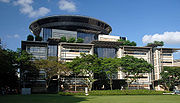| Shadrake v Attorney-General | |
|---|---|
 The Supreme Court Building, Singapore, on 10 February 2007 | |
| Court | Court of Appeal of Singapore |
| Full case name | Shadrake Alan v. Attorney-General |
| Decided | 27 May 2011 |
| Citations | [2011] SGCA 26, [2011] 3 S.L.R. 778 |
| Case history | |
| Appealed from | [2010] SGHC 327, [2011] 2 S.L.R. 445; [2010] SGHC 339, [2011] 2 S.L.R. 506 (sentence) |
| Court membership | |
| Judges sitting | Andrew Phang Boon Leong J.A., Lai Siu Chiu and Philip Pillai JJ. |
| Case opinions | |
| The "real risk" test is the test for the actus reus of the offence of scandalising the court in Singapore, and fair criticism is an element relevant to liability rather than being a defence. | |
Shadrake Alan v. Attorney-General is a 2011 judgment of the Court of Appeal of Singapore that clarified the law relating to the offence of scandalising the court. Alan Shadrake, the author of the book Once a Jolly Hangman: Singapore Justice in the Dock (2010), was charged with contempt of court by way of scandalising the court. The Prosecution alleged that certain passages in his book asserted that the Singapore judiciary lacks independence, succumbs to political and economic pressure, and takes a person's position in society into account when sentencing; and that it is the method by which Singapore's ruling party, the People's Action Party, stifles political dissent in Singapore.
In the High Court, Justice Quentin Loh made significant changes to the law when he rejected the use of the long-standing "inherent tendency" test that had been applied to establish the actus reus of the offence, and instead adopted a "real risk" test. This allows a court to take into consideration the circumstances surrounding the uttering or publication of the impugned words and to only hold someone liable if that person has created a real risk in the circumstances in which the impugned words were communicated. In addition, he ruled that should an impugned statement be found to have scandalised the court, the only applicable defence to contempt of court would be if the statement amounted to "fair criticism". In doing so, he rejected justification and fair comment as defences. Applying the real risk test, Justice Loh found that 11 out of 14 impugned statements were contemptuous and that the defence of fair criticism did not apply to any of the statements. The High Court thus found Shadrake guilty of the offence of contempt by way of scandalising the court and sentenced him to six weeks' imprisonment and a fine of S$20,000.
Upon appeal, the Court of Appeal, while upholding the use of the real risk test, made several changes to the way the test is to be applied. In addition, the Court clarified that fair criticism is an element that determines whether there is liability, rather than operates as a defence. The Court, when applying its modified test, found that only nine of the 14 statements were contemptuous. It upheld the sentence passed by the High Court.
Both the High Court and Court of Appeal judgments explored the rationale for the law against contempt of court and its relation with freedom of speech, and emphasised the importance of public confidence in the administration of justice which can be impugned by contempt of court.